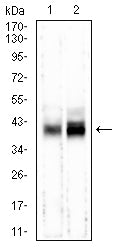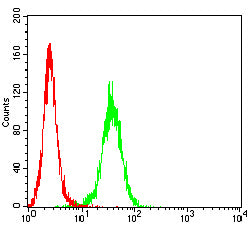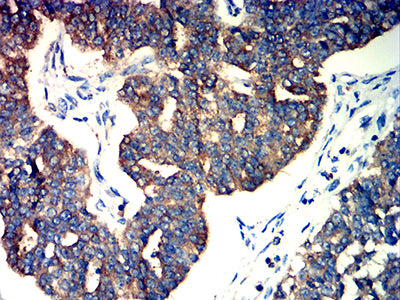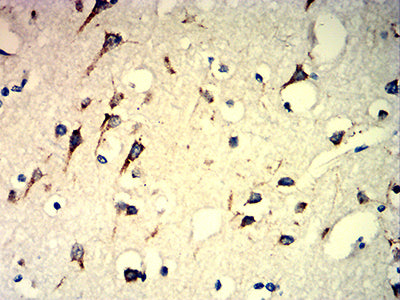




| WB | 1/500 - 1/2000 | Human,Mouse,Rat |
| IF | 咨询技术 | Human,Mouse,Rat |
| IHC | 1/200 - 1/1000 | Human,Mouse,Rat |
| ICC | 技术咨询 | Human,Mouse,Rat |
| FCM | 1/200 - 1/400 | Human,Mouse,Rat |
| Elisa | 1/10000 | Human,Mouse,Rat |
| Aliases | SMPR; MPR46; CD-MPR; MPR 46; MPR-46; CD-M6PR |
| Entrez GeneID | 4074 |
| clone | 1B11C1 |
| WB Predicted band size | 30.9kDa |
| Host/Isotype | Mouse IgG2b |
| Antibody Type | Primary antibody |
| Storage | Store at 4°C short term. Aliquot and store at -20°C long term. Avoid freeze/thaw cycles. |
| Species Reactivity | Human, Mouse |
| Immunogen | Purified recombinant fragment of human M6PR (AA: 124-277) expressed in E. Coli. |
| Formulation | Purified antibody in PBS with 0.05% sodium azide |
+ +
以下是关于M6PR(Mannose-6-Phosphate Receptor)抗体的3篇代表性文献及其摘要概括:
---
1. **文献名称**: *"Mannose 6-phosphate receptors: new twists in the tale"*
**作者**: Braulke T, Bonifacino JS (2009)
**摘要**: 该综述总结了M6PR(包括CI-M6PR和CD-M6PR)的结构与功能,重点讨论其在溶酶体酶运输中的作用,并提到利用特异性抗体研究其细胞内定位及疾病相关机制(如溶酶体贮积症)。
---
2. **文献名称**: *"The role of the cation-dependent mannose 6-phosphate receptor in the internalization of malarial proteases"*
**作者**: Ghosh S, et al. (2003)
**摘要**: 研究通过抗M6PR抗体阻断实验,证明CD-M6PR在疟原虫蛋白酶内吞中的作用,为靶向M6PR的病原体感染机制提供依据。
---
3. **文献名称**: *"Lysosomal enzyme trafficking: live-cell imaging with anti-M6P antibodies"*
**作者**: Reaves B, et al. (1996)
**摘要**: 利用抗M6PR抗体标记活细胞中的受体,实时观察溶酶体酶从高尔基体到溶酶体的运输路径,揭示动态调控机制及pH依赖性解离过程。
---
4. **文献名称**: *"Targeting M6PR in cancer: antibody-based therapeutic strategies"*
**作者**: Liu Y, et al. (2018)
**摘要**: 探讨M6PR在某些肿瘤中的高表达现象,并开发靶向M6PR的抗体-药物偶联物(ADC),通过体外实验验证其对肿瘤细胞的选择性杀伤作用。
---
这些文献涵盖M6PR的基础机制研究及抗体应用方向,可作为相关研究的切入点。
The **mannose-6-phosphate receptor (M6PR)** is a transmembrane glycoprotein critical for intracellular trafficking of lysosomal enzymes. Two forms exist: the cation-dependent M6PR (CD-MPR) and the cation-independent M6PR (CI-MPR, also known as IGF2R). Both recognize mannose-6-phosphate (M6P) tags on lysosomal hydrolases in the Golgi apparatus, directing their transport to lysosomes via clathrin-coated vesicles. CI-MPR additionally binds insulin-like growth factor 2 (IGF2), regulating its degradation, and participates in diverse processes like cell growth, apoptosis, and pathogen entry (e.g., viral entry).
**M6PR antibodies** are essential tools for studying receptor localization, expression, and function. They are widely used in techniques like Western blotting, immunofluorescence, and immunohistochemistry to investigate lysosomal biogenesis disorders (e.g., mucolipidosis), cancer (altered M6PR/IGF2R expression in tumors), and neurodegenerative diseases (impaired lysosomal function). Antibodies targeting specific epitopes or isoforms help dissect M6PR's roles in physiological and pathological contexts, including its hijacking by pathogens for cellular entry. Commercial M6PR antibodies are often validated for specificity across human, mouse, and rat models, aiding comparative studies. Their applications extend to therapeutic research, such as enzyme replacement therapies for lysosomal storage diseases, where M6PR-mediated uptake is crucial.
×